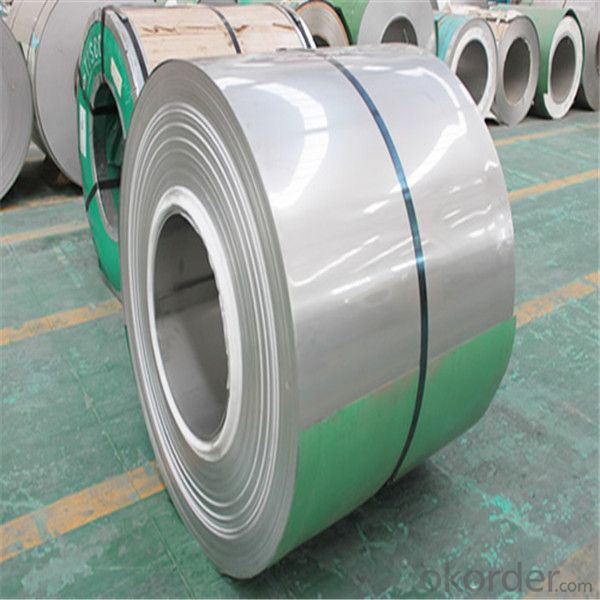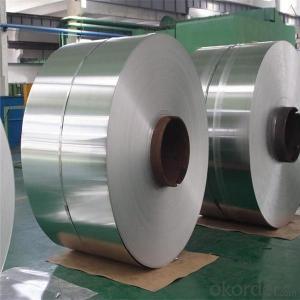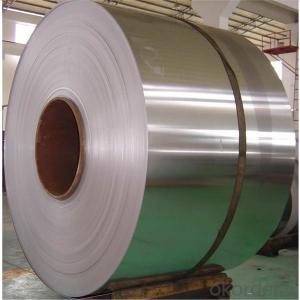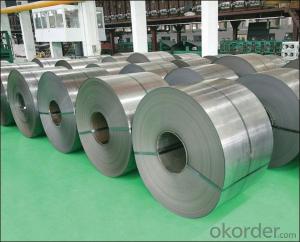201/304/430/ Stainless Steel Coil with good quality
- Loading Port:
- Shanghai
- Payment Terms:
- TT OR LC
- Min Order Qty:
- 5 m.t.
- Supply Capability:
- 24000 m.t./month
OKorder Service Pledge
OKorder Financial Service
You Might Also Like
Item specifice
stainless steel coil
1. Standard: ASTM A240, JIS G4304, G4305, GB/T 4237, GB/T 8165, BS 1449, DIN17460, DIN 17441
2. Grade: 200series&300series&400series
3. Thickness: 0.23mm-0.8mm
4. Diameter: 115-560mm
5. Length: according buyer require
6. Surface finish: 2B, BA, 8K, 6K, Mirror Finished, No1, No2, No4, Hair Line with PVC
7. Manufacture technology: cold drawn/cold rolled/hot rolled
1.Export Markets
Our target market is the international market. Every year we export most of products to countries like India, Pakistan, South Korea, Brazil, Australia, South Africa, Spain, Sri Lanka, russia,vietnam,Taiwan, Hong Kong, etc.
Type | Stainless steel coil (cold rolled ) |
Thinckness | 0.23mm-0.8mm |
Diameter | 115mm-560mm |
Quantity | as customer's requirement |
Finish | 2B,BA,HL,MIRROR,NO.1-NO.4,8K,and so on. |
Standard | ASME, ASTM, EN ,BS,GB,DIN, JIS etc |
Material | 201,202, 301,304,410,430,409 |
Application range | Foodstuff, Gas, metallurgy, biology, electron, chemical, petroleum, boiler, nuclear energy, Medical equipment, fertilizer etc |
Package | Standard export sea-worthy packing |
Delivery time | 7-15 days |
Quality | No.1 |
Productivity | 3000-4000 tons/month |
Note | We can produce other standard as the customers’ requirement |
2.Technical notes:
Surface Finish | Definition | Application |
2B | Those finished, after cold rolling, by heat treatment, pickling or other equivalent treatment and lastly by cold rolling to given appropriate luster. | Medical equipment, Food industry, Construction material, Kitchen utensils. |
BA | Those processed with bright heat treatment after cold rolling. | Kitchen utensils, Electric equipment, Building construction. |
NO.3 | Those finished by polishing with No.100 to No.120 abrasives specified in JIS R6001. | Kitchen utensils, Building construction. |
NO.4 | Those finished by polishing with No.150 to No.180 abrasives specified in JIS R6001. | Kitchen utensils, Building construction, Medical equipment. |
HL | Those finished polishing so as to give continuous polishing streaks by using abrasive of suitable grain size. | Building Construction. |
NO.1 | The surface finished by heat treatment and pickling or processes corresponding there to after hot rolling. | Chemical tank, pipe |
3.chemcial composition
Quality | Copper | NI | CU | Application |
PURE DDQ
| High | 1% | 1.4% | Sink, Deep drawing product |
DDQ | Middle | 1% | 1% | Pot, Bowl |
non-DDQ | Low | 0.5% | 0.5% | Plate, Bowl |


- Q:Can 111 stainless steel strips be passivated to enhance corrosion resistance?
- Yes, 111 stainless steel strips can be passivated to enhance corrosion resistance. Passivation is a process that removes iron from the surface of stainless steel and forms a protective oxide layer. This oxide layer acts as a barrier, preventing further corrosion and providing increased resistance to environmental factors such as chemicals, moisture, and temperature. Passivation is commonly used in various industries, including automotive, aerospace, medical, and food processing, to improve the longevity and performance of stainless steel components. Therefore, by passivating the 111 stainless steel strips, their corrosion resistance can be enhanced, leading to improved durability and reliability in their intended applications.
- Q:How are stainless steel strips different from galvanized steel strips?
- Stainless steel strips differ from galvanized steel strips primarily in terms of their composition and the way they are protected against corrosion. Stainless steel strips are made from an alloy of iron and chromium, which provides excellent resistance to rust and corrosion without the need for additional coatings. On the other hand, galvanized steel strips are made from regular steel that is coated with a layer of zinc to protect it from rust and corrosion. This zinc coating acts as a sacrificial layer, meaning it corrodes first before the steel underneath, providing a certain level of protection. However, stainless steel strips generally offer superior corrosion resistance and are more suitable for applications where long-term durability and resistance to harsh environments are required.
- Q:What is the electrical conductivity of stainless steel strips?
- The electrical conductivity of stainless steel strips can vary depending on the specific type and composition of stainless steel. Generally, stainless steel is not as conductive as other metals like copper or aluminum. The electrical conductivity of stainless steel is typically lower due to its higher resistance to the flow of electric current. However, there are stainless steel alloys that have been specifically designed for improved electrical conductivity. These alloys often contain higher levels of elements like nickel or copper, which enhance the material's conductivity. It is important to note that the electrical conductivity of stainless steel can also be affected by factors such as temperature, surface condition, and thickness of the strip. Therefore, it is advisable to refer to specific data or consult with manufacturers for accurate information on the electrical conductivity of stainless steel strips.
- Q:Can stainless steel strips be used in the aerospace manufacturing industry?
- Yes, stainless steel strips can be used in the aerospace manufacturing industry. Stainless steel is a highly versatile material that offers a unique combination of strength, durability, and resistance to corrosion, making it ideal for various aerospace applications. Stainless steel strips can be used in the production of aircraft components such as structural frames, fuel tanks, exhaust systems, and engine parts. Additionally, stainless steel's high-temperature resistance and ability to withstand extreme conditions make it suitable for aerospace applications where the material needs to maintain its integrity under demanding environments. Overall, stainless steel strips are a reliable and widely used material in the aerospace manufacturing industry.
- Q:How do stainless steel strips resist scaling?
- Stainless steel strips resist scaling due to the presence of chromium in their composition. Chromium forms a protective oxide layer on the surface of the steel, preventing oxidation and the formation of scales even at high temperatures.
- Q:What are the advantages of using stainless steel strips in the automotive industry?
- There are several advantages of using stainless steel strips in the automotive industry. Firstly, stainless steel is known for its high strength and durability. It offers excellent resistance to corrosion, heat, and wear, making it suitable for various automotive applications. Stainless steel strips can withstand harsh environments, such as extreme temperatures and exposure to chemicals, without losing their structural integrity. This longevity ensures that automotive components made from stainless steel strips have a longer lifespan, reducing the need for frequent replacements and increasing overall efficiency. Secondly, stainless steel strips have a high aesthetic appeal. With their sleek and shiny appearance, stainless steel strips can enhance the overall visual appeal of automotive parts. This is particularly important in the automotive industry, where aesthetics play a crucial role in attracting customers. Moreover, stainless steel strips are highly formable and can be easily shaped into different sizes and dimensions. This flexibility allows manufacturers to create intricate and custom-designed automotive components, meeting the specific requirements of various vehicle models. Additionally, stainless steel strips can be easily welded, allowing for seamless integration in automotive structures. Another advantage of stainless steel strips is their excellent resistance to impact and vibration. This makes them ideal for use in the automotive industry where components are subject to constant stress and movement. Stainless steel strips can absorb shocks and vibrations, reducing the risk of damage to critical automotive parts and ensuring the safety of drivers and passengers. Furthermore, stainless steel is a sustainable and eco-friendly material. It is 100% recyclable, making it an environmentally responsible choice for the automotive industry. By using stainless steel strips, manufacturers can contribute to reducing waste and conserving natural resources. In conclusion, the advantages of using stainless steel strips in the automotive industry are numerous. From its high strength and durability to its aesthetic appeal and formability, stainless steel offers a range of benefits that enhance the performance and efficiency of automotive components. Its resistance to corrosion, impact, and vibration, along with its sustainability, make it a reliable and eco-friendly choice for the automotive industry.
- Q:Are stainless steel strips suitable for decorative railing systems?
- Yes, stainless steel strips are suitable for decorative railing systems. They offer a sleek and modern look, are highly durable and resistant to corrosion, and can be easily customized to achieve various aesthetic designs.
- Q:What are the different types of protective coatings for stainless steel strips?
- There are several types of protective coatings available for stainless steel strips, each offering different levels of protection and serving specific purposes. 1. Paint Coatings: One of the most common types of protective coatings for stainless steel strips is paint. These coatings provide a layer of barrier protection against corrosion, as well as enhance the aesthetic appearance of the stainless steel. Paint coatings can be applied in various forms, such as liquid or powder, and can be customized in terms of color and finish. 2. Powder Coatings: Powder coatings are another popular option for protecting stainless steel strips. These coatings are applied as a dry powder and then heated to form a protective film. Powder coatings offer excellent durability, resistance to corrosion, and can be applied in a wide range of colors and textures. 3. Electroplating: Electroplating is a process where a thin layer of metal, such as zinc or nickel, is bonded to the stainless steel surface. This coating provides a sacrificial layer that protects the stainless steel from corrosion. Electroplating is commonly used in industries where stainless steel strips are exposed to harsh environments or corrosive substances. 4. PVD Coatings: Physical Vapor Deposition (PVD) coatings involve depositing a thin film of material onto the stainless steel surface using a vacuum chamber. These coatings offer excellent durability, resistance to wear and corrosion, and can be customized to provide specific properties like enhanced hardness or low friction. 5. Passivation: Passivation is a chemical treatment process that removes contaminants from the stainless steel surface and forms a passive oxide layer. This layer enhances the stainless steel's natural corrosion resistance. Passivation is often used as a final step after fabrication or machining of stainless steel strips. 6. Organic Coatings: Organic coatings, such as acrylics or epoxies, are often used to provide a protective layer for stainless steel strips in industrial or marine environments. These coatings are resistant to chemicals, UV radiation, and abrasion, offering long-lasting protection against corrosion. It is important to select the appropriate protective coating for stainless steel strips based on the specific application, environmental conditions, and desired level of protection. Consulting with a coating specialist or manufacturer is recommended to ensure the right coating is chosen for the intended use.
- Q:Can stainless steel strips be formed into coils or rolls?
- Stainless steel strips have the capacity to be shaped into coils or rolls. Typically, stainless steel strips are manufactured in coil form and can be easily wound into a coil or roll shape. This quality makes them highly convenient for transportation, storage, and subsequent processing. The formation of stainless steel strips into coils or rolls involves a combination of bending, coiling, and winding techniques, which yield compact and tightly wound stainless steel coils. These coils or rolls can then find utility in a wide range of applications, including but not limited to manufacturing, construction, automotive, and various other sectors. The ability to shape stainless steel strips into coils or rolls enhances their versatility, thus rendering them a favored choice in numerous industries.
- Q:What are the factors affecting the weldability of 111 stainless steel strips?
- The factors affecting the weldability of 111 stainless steel strips include the composition and purity of the steel, the presence of impurities or contaminants, the heat input during welding, the welding technique used, the type and composition of the filler material, and the welding parameters such as current, voltage, and travel speed. Additionally, the condition of the surface, including its cleanliness and roughness, can also affect the weldability of the stainless steel strips.
1. Manufacturer Overview |
|
|---|---|
| Location | |
| Year Established | |
| Annual Output Value | |
| Main Markets | |
| Company Certifications | |
2. Manufacturer Certificates |
|
|---|---|
| a) Certification Name | |
| Range | |
| Reference | |
| Validity Period | |
3. Manufacturer Capability |
|
|---|---|
| a)Trade Capacity | |
| Nearest Port | |
| Export Percentage | |
| No.of Employees in Trade Department | |
| Language Spoken: | |
| b)Factory Information | |
| Factory Size: | |
| No. of Production Lines | |
| Contract Manufacturing | |
| Product Price Range | |
Send your message to us
201/304/430/ Stainless Steel Coil with good quality
- Loading Port:
- Shanghai
- Payment Terms:
- TT OR LC
- Min Order Qty:
- 5 m.t.
- Supply Capability:
- 24000 m.t./month
OKorder Service Pledge
OKorder Financial Service
Similar products
New products
Hot products
Hot Searches
Related keywords




























